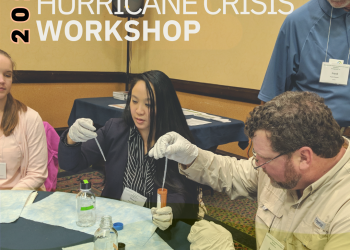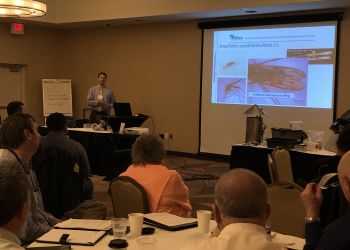 The U.S. Food & Drug Administration’s (FDA’s) Voluntary National Retail Food Regulatory Program Standards (Retail Program Standards) are designed to help food regulatory programs enhance the services they provide to the public.
The U.S. Food & Drug Administration’s (FDA’s) Voluntary National Retail Food Regulatory Program Standards (Retail Program Standards) are designed to help food regulatory programs enhance the services they provide to the public.
This post is the third in NACCHO’s Retail Program Standards blog series showcasing the progress that communities across the country have made in retail food protection. Each month, we are featuring the experiences, challenges, and successes of jurisdictions that have worked toward each standard.
All jurisdictions featured have participated in NACCHO’s Retail Program Standards Mentorship Program, which provides peer-to-peer assistance and intensive technical support to help jurisdictions conform with the standards efficiently and effectively.
Note: Applications for both mentors and mentees for the eighth cohort of the mentorship program are due by October 19, 2018. Learn more.
This month we are focusing on Standard 2: Trained Regulatory Staff, and we have responses from two jurisdictions:
- Gary Coggins, Environmental Health Senior Manager, New River Health District, Christianburg, VA
- Roy Kroeger, Environmental Health Supervisor, Cheyenne-Laramie County Health Department, Cheyenne, WY
What steps did you take to get started in your work on Standard 2?
Coggins: We applied for and were paired with a mentor to help us work on Standard 2 through NACCHO’s Retail Program Standards Mentorship Program. We then formed an internal volunteer workgroup to draft a workplan and tackle the project. Next, we completed an updated self-assessment for Standard 2 to understand where our specific gaps were and to guide our workplan. The self-assessment and the workplan merged as we collected all our available documentation for training, continuing education, etc.
Kroeger: To get started, we reviewed the standard and asked our retail specialist questions about specifics. We also reviewed training records (or lack thereof), got a commitment from policy makers to support the effort, and determined our needs to meet the standard.
What was your biggest challenge in working toward Standard 2, and how have you worked to overcome that challenge?
Coggins: We encountered two big challenges through the process. First, we did not have a clearly written and well documented training procedure locally. We had relied heavily on the central state office to train and certify staff as competent and ready to conduct inspections. Overcoming this early hurdle led to the other challenge, which was thoroughly understanding the two options available for demonstrating successful completion of the pre-inspection curriculum, as we had staff who fell under both options. We had to refer back to the standard several times to be certain that each staff successfully met one or the other depending on their circumstances and the training program in place at the time of their hire or assignment to the food safety Program.
Kroeger: Finding the time to do the training with existing staff and then completing the assessment inspections were challenges. We made it a priority to do the online classes and then used routine inspections as the assessment inspections.
What outcomes and benefits came out of working on Standard 2?
Coggins: Creating an internal workgroup promoted buy-in and engagement among staff, providing them the opportunity to have direct input on our food safety policies and procedures. The workgroup remains active and continues to contribute to our program as we work on conforming to each of the nine standards. We created a local training procedures manual and implemented an organized system for tracking progress and maintaining documentation.
Kroeger: We now have a more consistent and thorough inspection, so industry sees the same inspection standard regardless of the inspector.
How do you sustain momentum in your work on Standard 2?
Coggins: The workgroup and tools created helped simplify our maintenance of a trained regulatory staff. The buy-in and engagement born of the process have provided a yearning to continue to work toward all of the standards. Maintaining the workgroup and actively working on program improvement have created their own momentum for our program.
Kroeger: It is written into policy, so new staff come in knowing what they have to do to meet job expectations. Doing the assessment inspection every three years is still a challenge, but it has become a required procedure and just gets done. Everyone understands the importance of the program.
What tips do you have for other jurisdictions working toward Standard 2?
Coggins: We would encourage any jurisdiction to apply to be a part of NACCHO’s Retail Program Standards Mentorship Program. We worked closely with our mentor and borrowed heavily from their success and the tools they could share. There are many resources available through FoodSHEILD, NACCHO, or your own network of professional colleagues. A lot of great work has already been done on all the Standards, and most of it can be adapted to suit another jurisdiction. We also recommend working with your FDA Regional Retail Food Specialists, as they are a tremendous resource.
Kroeger: Don’t feel overwhelmed. Working with government, there are always new challenges. Completing this or any other standard is designed to help your program. Take your time and figure out what you need to do before jumping in without a plan. There are some minimal time requirements, but having a year to complete the assessments for each inspector allows flexibility to help with implementation.
How has your work on the Retail Program Standards overall affected your community in terms of public health outcomes?
Coggins: Well, this is the “million-dollar question.” We have a verifiable conformance with a couple of standards now. Anecdotally, we know this has improved our relationship with industry and those we are regulating, and hopefully, it also boosts consumer confidence in the work we do. We want to quantify this and find out any measurable effects. We hope to be able to show a reduction in foodborne illness risk factors as we continue to work on the Retail Program Standards. To do this, we initiated a risk factor study in 2017 (as part of Standard 9), and we are in the process of completing the analysis of that study and creating a report. This will establish our baseline, and in the coming years we will conduct another study to quantify the effect of our work.
Kroeger: The biggest results for our stakeholders are a better inspection that spends more time looking at risk factors to reduce food borne illness and a more consistent inspection process so our establishments are not hearing different messages from different inspectors.
Stay tuned for the next post, which will focus on Standard 3: Inspection Program Based on HACCP Principles, coming in November.
Contact Amy Chang at [email protected] with any questions.






